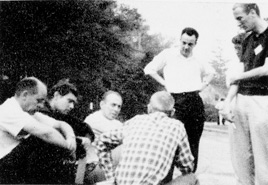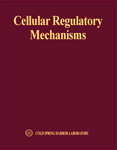|
XXVI: Cellular Regulatory Mechanisms 1961 |
|
|

|
From left: Dr. T.F. Anderson,Dr. Syndney Brenner, Dr. James Watson, Dr. Francois Jacob, Dr. Frank Stahl, Dr. Alfred Hershey (back to camera) SYMPOSIUM SYNOPSIS LIST OF PARTICIPANTS CONTENTS OF SYMPOSIUM VOLUME PHOTOGRAPHS PUBLISHED VOLUME  |
Cellular Regulatory Mechanisms
4–12 June, 1961
Symposium Synopsis
Organizer: Arthur Chovnik
Advisors: Bernard D. Davis, Eugene W. Knox, Jacques Monod, Van R. Potter, Gordon M. Tomkins & H. Edwin Umbarger
1961 was an annus mirabilis for molecular genetics and Arthur Chovnick's choice of Cellular Regulatory Mechanisms was inspired. As he commented in the introduction, for some twenty years, studies of the genetic control of cell metabolism had followed two lines of research , and these had come together at this Symposium.
One line of research concerned the regulation of enzyme activity through control of enzyme synthesis, by induction or repression. Induction was first analyzed by Monod who showed that E. coli began rapid synthesis of beta-galactosidase when lactose-the substrate for the enzyme-was added to the culture medium. Repression (or feedback inhibition) was the complement; here enzyme activities in a synthetic pathway were inhibited by the products of those pathways. Art Pardee, for example, found that uracil or cytosine inhibited the synthesis of aspartate transcarbamylase, the enzyme that catalyzes a step in the pathway making those pyrimidines. Early in 1961, Jacob and Monod had published their classic paper that developed a model to account for inducible and repressible enzyme systems and they presented their new model to their peers.
The second line of research dealt with the biochemical foundations of the Central Dogma-how the information in the DNA molecule was used by the cell to make proteins. Although was not known how information was encoded in DNA (the genetic code would have to wait for the 1966 Symposium), two groups had demonstrated the existence of messenger RNA that carried genetic information from DNA in the nucleus to the cytoplasm where protein synthesis took place. Another component had been identified by Paul Zamecnik and Mahlon Hoagland-soluble (later called transfer) RNAs that carried amino acids to the ribosomes where the amino acids were incorporated into proteins. These had been predicted on theoretical grounds by Francis Crick, although transfer RNAs turned out to be rather different from his "adaptor molecules". The full details of protein synthesis were still being worked out and would be the topic of the 1963 Symposium.
Search images: